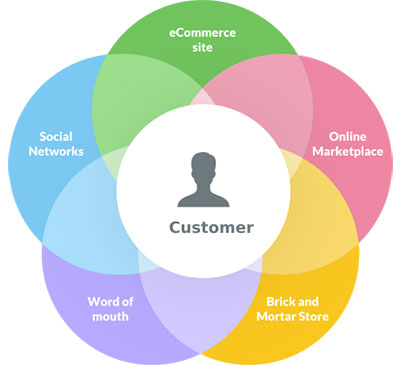How to Grow your eCommerce Business in 2020


eCommerce is a booming industry that has changed the game of how people transact. The CAGR over the years is an indicator of its massive potential, and 2020 looks to be even better. If you’re looking to grow your own eCommerce business, then there isn’t a better time. It is easy to set up an online store, and with the right tools, you can be profitable in no time!
eCommerce in 2019 hit a record high of $3.46 trillion, with 2020 expected to bring in $3.9 trillion. Combine this with the fact that next year will see automation capabilities improve, and you have enough incentive to begin.
Not only is eCommerce a great way to make money, but it’s also an awesome way to save it. India’s own eCommerce business is expected to be in the range of $250 billion next year. If you’re looking to grow your eCommerce business, you’ve found yourself in the right place at the right time. India is amongst the top ten fastest-growing eCommerce markets in the world.
Brick-and-mortar overheads include rental, electricity, and shopping space costs whereas eCommerce is all about convenience. The process of being able to shop online has become oversimplified that all you require is a mobile. To put that in perspective, the U.S.A expects 42.9% of all sales come only from mobile devices in 2020.
With the wind well and truly in your direction, we can’t emphasize how crucial it is to start now. This is a golden period for Indian eCommerce, with companies such as Nykaa, Zilingo, and Flipkart prospering. They have grown into multi-million-dollar behemoths within a matter of a few years. The potential for growth is abundant, and it’s time you tap into the same.
How to Grow Your eCommerce Business?
Growing your eCommerce business is vital. It involves a network of strategies working in synergy. Many people begin well but can’t keep up with mounting demand.
A classic case of a company that wasn’t able to succeed is Snapdeal. From raising a total of $1.6 billion, they have had to lay off most of their employees due to poor execution. Other factors included diversifying into more products when their primary business itself wasn’t profitable yet.
In eCommerce, as in any business, getting profitable first is critical. Find the one USP of your product or service and leverage the most from it. Ensure that this is the primary resource for cash influx before you proceed to grow. Also, identifying the right strategies are key, and we’ve simplified them for you below.
Marketing, lead capturing, and retargeting are a few examples of online functions. To ensure their success, you will have to employ a few channels to manage your store better.
Of course, the methods we’d suggest aren’t going to be the only way you succeed. eCommerce is still a growing sector, and no company has got it entirely right. However, by trying out different strategies, you’ll begin to identify the ones that bring in the most ROI. Focus on developing those to grow, and you’ll become profitable soon.
We’ve included a list of some useful strategies to help you out. These have been curated to help kickstart your business in style:
1. Omnichannel Strategies
An omnichannel strategy is a holistic approach to marketing and sales. It provides a fully integrated shopping by combining the best user experiences. These include mobile browsing, brick-and-mortar experiences, reward points, and so much more! It is a great way to integrate the digital and analog world by finding a middle ground where everything is in sync.
A classic example of using this strategy is by taking a cue from Disney. Disney allows users to access their purchases, in-app selections, and more throughout their online devices. If you add a product in your cart on a computer at Disneyland, it will automatically show up on the app on your device as well. This well-oiled omnichannel strategy ensures your interactions are traceable and easier to access, resulting in sales.

In 2020, it is crucial to create an omnichannel strategy because it directly translates to better sales. If you’re able to engage your audience on multiple fronts, you’re bound to receive better mind recall in your customer. If a customer engages with a brand on more than ten channels, they’re 47% more likely to make more purchases.
To develop an omnichannel strategy for your business online, make sure you’ve identified your audience base. By understanding where your audience groups shop online, you make it easier to target and convert them. Identify the avenues where you can implement omnichannel marketing.
Tools like Google Analytics and Shopify help you identify what touchpoints an individual customer goes through. This includes channels like social media, Google searches, AdSense, and more. It’s essential that you bridge the gap between offline and online and make each touchpoint profitable as well.
Back home, Indian companies like Raymond have launched stores that uniquely integrate omnichannel presence. Customers can click on a “trial” button and get their selected clothes to appear in the desired size in the trial room. The method helped generate higher footfalls, and they do plan on opening more stores due to this.
You could employ similar methods on a digital store to provide customers with an experience that mirrors a real-time purchase.
2. Cross-Border Commerce

For anyone not banking on this strategy, here’s a quick fact – cross-border eCommerce is said to touch a whopping $1 trillion next year. It refers to trade across borders, i.e., international. However, these trades are all made online. The opportunity for cross border eCommerce is significant, in any case. In Singapore alone, close to 96% of retailers feel that having an international presence is a must.
Cross border eCommerce opens doors to better returns and the ability to penetrate an international market. If you’re able to sell in a country where the exchange rate is higher, your revenues will also translate to higher numbers. It also opens doors for customers to transact internationally. They can then bridge the gap between their desired product and distance.
However, there are a few risks that concern cross border eCommerce. Primary of these being fraud. Merchants tend to overcharge and indulge in malpractice, which can lead to loss of money in transit. The products promised may not be of the quality expected, and this can derail your business, especially if you’re just starting. Finding the right payment tools is an absolutely crucial step in this direction. Another worrisome aspect includes logistics, where the time taken for a product to reach can be long and where Government regulations also need to be checked continuously.
To develop a strong cross border eCommerce plan in 2020, do your research on foreign market availability. If you feel your product will be in demand, then try to deploy test runs internationally. This may cost you, but in the long term, you’ll be able to make your money back.
It’s also vital to understand government regulations. Head over to the internet, call up a lawyer specialized in international trade and figure it out. Doing your due diligence on this facet will save you loads of money in shipping, logistics, and customs, so make sure you’ve got this checked.
3. PPC Advertising

PPC advertising is one of the most shrewd investments you can make online. Google, Bing, and other channels allow you to advertise and make money off their platforms. But before you jump the gun, you’ve got to understand Pay-Per-Click and how it works.
PPC Advertising, in a nutshell, is all about placing an eCommerce ad on an online platform and when a customer clicks on it, you stand a chance of making money. There are different forms of paid advertising. Let’s elucidate the ones you must focus on in 2020:
- Google Ads – Google ads are one of the most popular types of PPC advertising. 63% have admitted to buying something directly off an advertisement on Google.
- Facebook Ads – Facebook ads are a great way to re-target customers who have visited. It’s the best platform to invest in if a majority of your customers shop directly through social media. The mobile device is the differentiating factor, with 87% of Facebook’s advertising revenue coming purely from mobile ads.
- Instagram Ads – Instagram ads are another trend to watch out for in 2020 where 63% of their users log in at least once a day, so they are returning customers. You’ll also be able to reach out to a young audience of up to 53 million individuals. And that’s some mind boggling figure to tap into!
To develop an active PPC campaign, ensure that you’ve segregated your eCommerce store well. Your audience shops through different channels, so make sure you’re able to give them what they want. First-time buyers are best on Google, re-targeting buyers are best done on Facebook, and younger buyers are best targeted on Instagram.
Identify the keywords that are being used by customers online and incorporate the same onto your content. It will help you rank higher on searches and also index you in similar searches. For Facebook, ensure you’ve got your advertising dimensions right and with clear messaging, so there’s no confusion. While PPC can be taxing on your purse, it’s also not recommended if you’re just starting. SEO is a more organic way to go about this as it allows you to be more in control of your content appearing on your site. Every ad must contain a link to the store so your customer can directly explore or purchase as required.
4. Affiliate Marketing

The next time someone asks you if affiliate marketing works, just let them know – it’s on track to become a $6.8 billion industry in the United States alone! Affiliate marketing entails advertising a company’s products on your website. These sites pay you a commission for advertising on your site in the hope that readers or visitors click on the link. This drives traffic towards their site and revenue into yours. Some of the most successful eCommerce stores that use affiliate marketing include Amazon, Rakuten, and GearBest.
If you are planning to start with affiliate marketing then we recommend you reach out to top affiliate marketers which include GoDaddy, who provide a 40% commission, Amazon Associates, which displays over a million products and Skimlinks, who offer a 25% commission.
To begin an affiliate program, try to find a mix of generic and industry-specific affiliates. You can head to one of the websites such as Amazon and allow them to advertise similar products on your site. If you’re an electronics company, for example, you can get them to showcase their products on your site and drive revenue with each click. Another way to go about would be by creating a “bestselling products” link on your website and driving traffic towards Amazon, thus increasing your revenue.
As long as you can find a niche segment that allows you the freedom to advertise as you like, you’re sure to see more people depending on your content. This will result in them clicking on your links, bringing you money.
Conclusion
Thus, with these strategies, you should be well on your way to grow your eCommerce business. Just give it the time it requires, and you’ll start to notice the difference.
The different types of strategies you could employ are tried and tested methods that hold good stead in the future. The digital world moves fastest, and that’s why techniques such as omnichannel marketing and PPC require constant updating. Get a strong team that will optimize your site, and you’ll begin to move up the search rankings.
Additionally, you could also tap into some additional resources, which include paid blogs, shopping cart functionality, and home page personalization that makes for a delightful experience. Ensure you’re always up to date with the latest happenings in the world of eCommerce and are innovating every few weeks.
2020 holds much promise, with growth expected across all sectors in eCommerce. Keep an eye out for trends, your competitor’s pricing, and innovative marketing methods. eCommerce looks well and indeed the way forward for shopping. If you manage to find the right avenues to market and sell, you could probably hit your first million within a year or two, because that’s the exponential growth in this industry for a successful business!
Subscribe to our blog and stay updated!
By completing this form, I agree to Vinculum’s privacy policy














